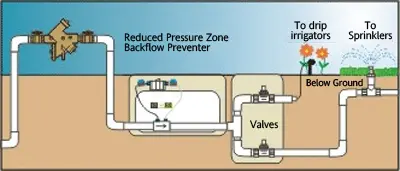How Often Should Backflow Testing Be Done?
Wondering about the importance of backflow testing and how often it should be carried out? You're in the right place! In this blog, we'll break down what backflow testing is, its significance, and the recommended frequency to ensure your water supply remains safe and contamination-free. Let's dive in and make this complex topic as simple as enjoying a cup of coffee!
Understanding Backflow: What It Is and Why It Matters
Backflow is a term that refers to the undesired reverse flow of water in a plumbing system. This can lead to the contamination of clean water supplies when substances from pools, storage, or other sources mix with the potable water line. The significance of preventing backflow cannot be overstated, as it safeguards against the risks posed by contaminants and pathogens that could compromise the health of communities. Ensuring the proper functionality of backflow preventers through regular testing is crucial for maintaining a secure and healthy water supply.
Backflow can occur due to several reasons, such as changes in water pressure, leading to either back pressure or back siphonage. Given the potential health hazards, backflow prevention is a critical component of municipal water systems and individual plumbing systems alike. By keeping contaminated and potable water streams separate, backflow preventers play a key role in maintaining public health and safety.
The Role of Backflow Testing in Water Safety
Backflow testing is an essential procedure to ensure that backflow prevention devices are functioning correctly. Certified professionals perform these tests to identify any possible malfunctions or failures that could allow contaminated water to seep into the clean water supply. Regular inspections and maintenance are fundamental to prevent such undesirable incidents and to comply with health and safety regulations.
The critical role of backflow testing in water safety cannot be understated. Ensuring the integrity of drinking water is a top priority for municipalities and requires adherence to state and national guidelines. These tests provide peace of mind for both homeowners and businesses, affirming that their water remains safe for consumption and use.
Recommended Frequency for Backflow Testing
The frequency of backflow testing can vary depending on local regulations, the type of backflow preventer installed, and the specific risks present at the site. Generally, it is recommended that backflow preventers be tested at least annually to ensure they function properly. This annual check is not only a safety measure but also a regulatory requirement in many areas.
For certain high-risk environments, such as healthcare facilities or industrial plants, more frequent testing—potentially semi-annually or quarterly—may be advised to address the increased risk of contamination. Consulting with a qualified backflow prevention expert can help determine the appropriate testing frequency for your specific circumstances.
Understanding Local Regulations and Guidelines
Local regulations and guidelines play a pivotal role in determining the specifics of backflow testing. These can vary significantly from one municipality to another, reflecting local water supply risks and health goals. It is crucial for property owners to be aware of and comply with these local requirements to ensure their plumbing systems do not pose a risk to the community's water supply.
Staying informed about the latest regulations and updates is also essential, as changes can affect testing schedules and requirements. Property owners can consult with local water authorities or professional backflow testing services to ensure their compliance and protect the safety of their water.
Consequences of Neglecting Backflow Testing
Neglecting regular backflow testing can have serious consequences, including contamination of the public water supply, which could lead to waterborne illness outbreaks. Furthermore, failure to comply with local backflow prevention testing regulations can result in fines, legal liabilities, and even the disconnection of water services. The health and financial implications underscore the necessity of adhering to recommended backflow testing schedules.
Apart from regulatory repercussions, there is a responsibility to the greater community to maintain clean and safe water supplies. A single instance of backflow contamination can affect not just one property but entire neighborhoods, posing health risks to a large number of people. Regular testing is a critical investment in public health and safety.
How to Prepare for a Backflow Test
Preparing for a backflow test involves several steps, including scheduling the test with a certified backflow tester, ensuring clear access to the backflow device, and temporarily shutting off irrigation systems or equipment connected to the system. Property owners should also review any previous test reports to be aware of potential concerns that might need addressing.
It's beneficial to have a basic understanding of how your backflow prevention device operates so you can recognize signs of malfunction or failure. Being prepared for the test not only facilitates a smooth assessment process but also enhances your ability to maintain a safe water system year-round.
Choosing a Certified Backflow Testing Service
Selecting a certified backflow testing service is a decision that should not be taken lightly. Look for providers with a strong reputation, proper certification, and significant experience in the field. Companies like Diamond Scenery offer expert testing services, ensuring that customers meet all regulatory requirements while safeguarding their water supply.
Before making your selection, consider asking for references or reviewing testimonials from previous clients. Such steps can help ensure you choose a reliable and competent service provider for your backflow testing needs, contributing to the ongoing safety of your water supply.
Securing Water Safety Through Regular Backflow Testing
Ensuring your water supply is safe and free from contamination is crucial for your health and well-being. Regular backflow testing is a key preventative measure that can help maintain the quality of your water by preventing contamination. By adhering to the recommended frequency of backflow testing, you can rest assured that your water supply is protected. Remember, when in doubt, it's always better to test more frequently to safeguard your home or business against the risks of backflow. Secure your peace of mind and your water's safety by booking a backflow test with us today at Diamond Scenery.

